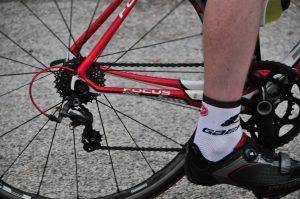1. A fitting bicycle

The most important aspect of a fitting bicycle is a well-adjusted saddle height. To determine the correct height of a saddle, a foot is placed on a pedal in its lowest position. Seated on the saddle, and with the foot in this position, the knee may not be stretched. With the saddle at the right height you can not put the feet flat on the ground. This has consequences for mounting the bicycle and riding off.
There are no clear rules for adjusting the handlebars. Therefore, the cyclist’s feeling is decisive here: some cyclists like to lean forward slightly, and others prefer to sit upright.
The gear of the bicycle must be selected such that during the exercises it is not necessary to switch gears. In none of the exercises it is necessary to ride faster than 15 km/h. If you reach that speed with a comfortable number of revolutions per minute then the gear is well set.
When using an e-bike, the pedal assistance is also selected on the basis of the ease with which one can cycle 15 km/h: if you can maintain this speed in a comfortable way, then the correct pedal assistance is selected.
In several exercises, braking is required. Therefore, it is important that the brakes are properly adjusted. “Well adjusted” means here that the brake levers can be easily grasped with the fingers and that a slight pressure on the brake levers is sufficient to slow down the bicycle.
2. Appropriate clothing

Cycling is moving, and therefore one needs clothing that allows one to move easily. Preferably we wear pants and flat shoes. A skirt or dress up to knee height is also possible, but less desirable. A skirt or other garment reaching to the ankles is unsuitable. If it is so cold that a coat is needed, wear a short coat.